Discussing Motivation Theories and Their Modern Workplace Application
VerifiedAdded on 2023/06/10
|8
|2164
|294
Essay
AI Summary
This essay provides a detailed analysis of several prominent motivation theories and their practical applications within the modern workplace. It begins with an introduction to the concept of motivation, followed by an in-depth examination of Maslow's Hierarchy of Needs Theory, explaining its stages and advantages and disadvantages. The essay then explores Herzberg's Hygiene and Motivational Theory, outlining hygiene and motivational factors, and their impact on job satisfaction. Furthermore, it delves into Adam's Equity Theory, discussing the dynamics of overpaid and underpaid inequity, and equity, with their advantages and disadvantages. The essay also covers Taylor's Motivational Theory, including its key elements like scientific methods and performance-based pay. The conclusion summarizes the importance of motivation in organizations and the role of Human Resource Management in applying these theories to enhance productivity and achieve organizational goals.
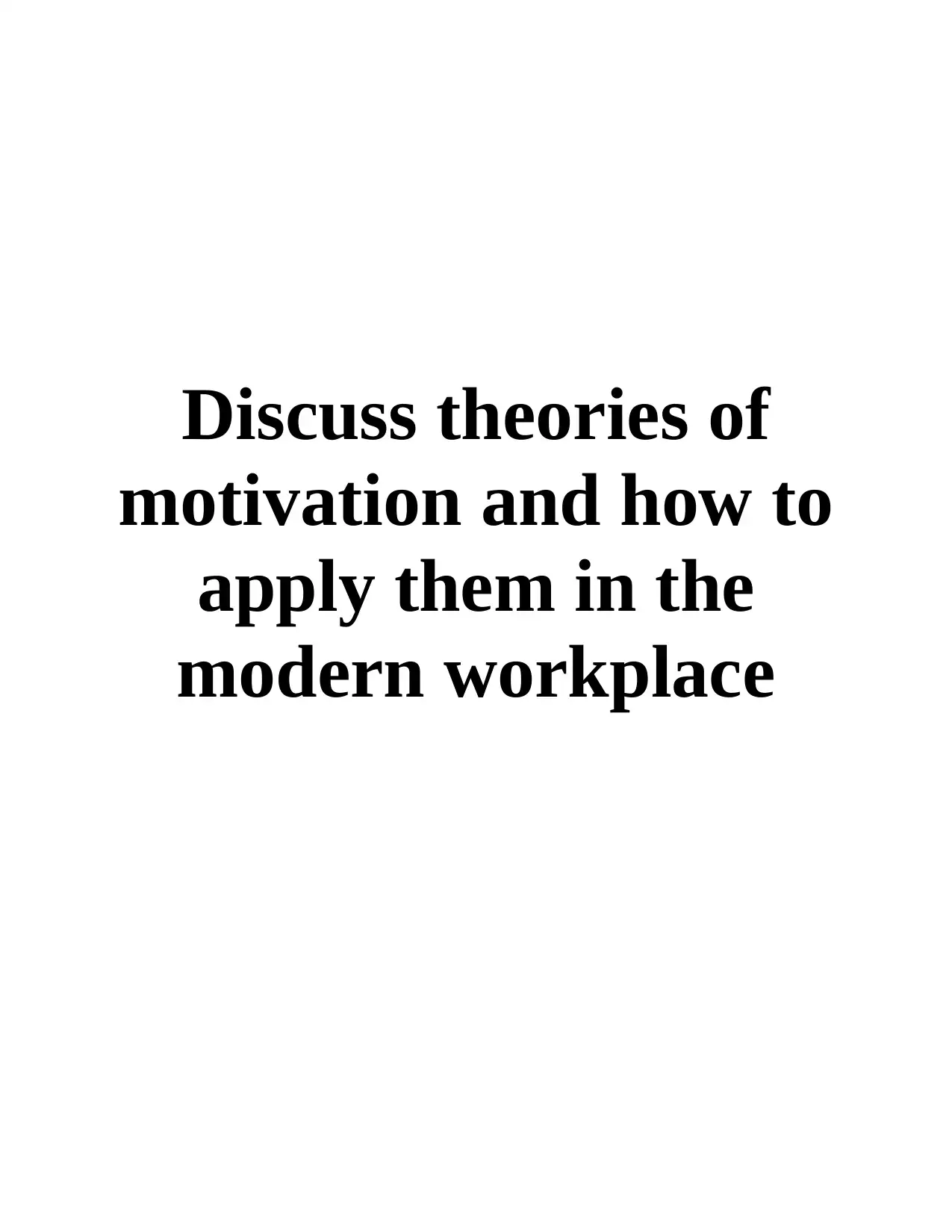
Discuss theories of
motivation and how to
apply them in the
modern workplace
motivation and how to
apply them in the
modern workplace
Paraphrase This Document
Need a fresh take? Get an instant paraphrase of this document with our AI Paraphraser
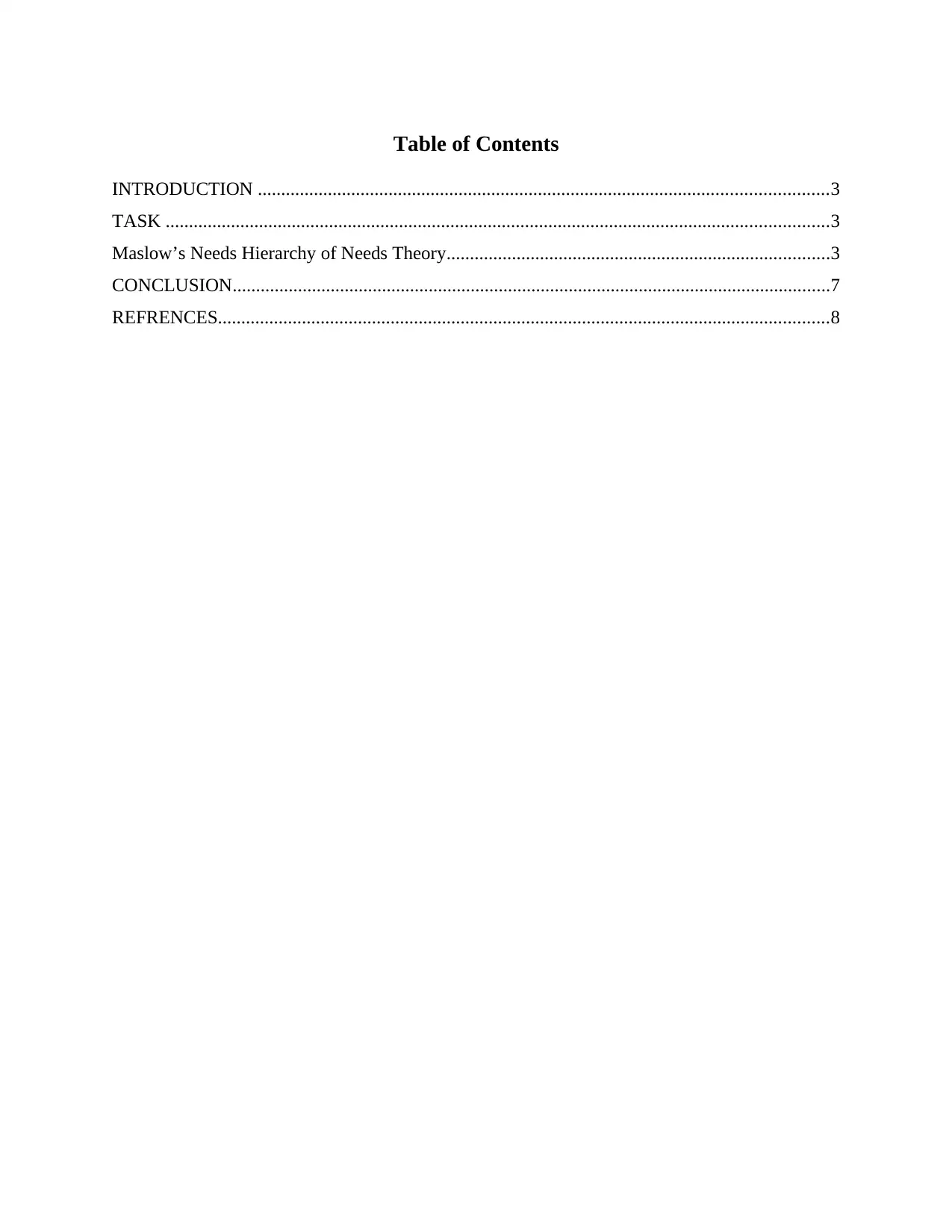
Table of Contents
INTRODUCTION ..........................................................................................................................3
TASK ..............................................................................................................................................3
Maslow’s Needs Hierarchy of Needs Theory..................................................................................3
CONCLUSION................................................................................................................................7
REFRENCES...................................................................................................................................8
INTRODUCTION ..........................................................................................................................3
TASK ..............................................................................................................................................3
Maslow’s Needs Hierarchy of Needs Theory..................................................................................3
CONCLUSION................................................................................................................................7
REFRENCES...................................................................................................................................8
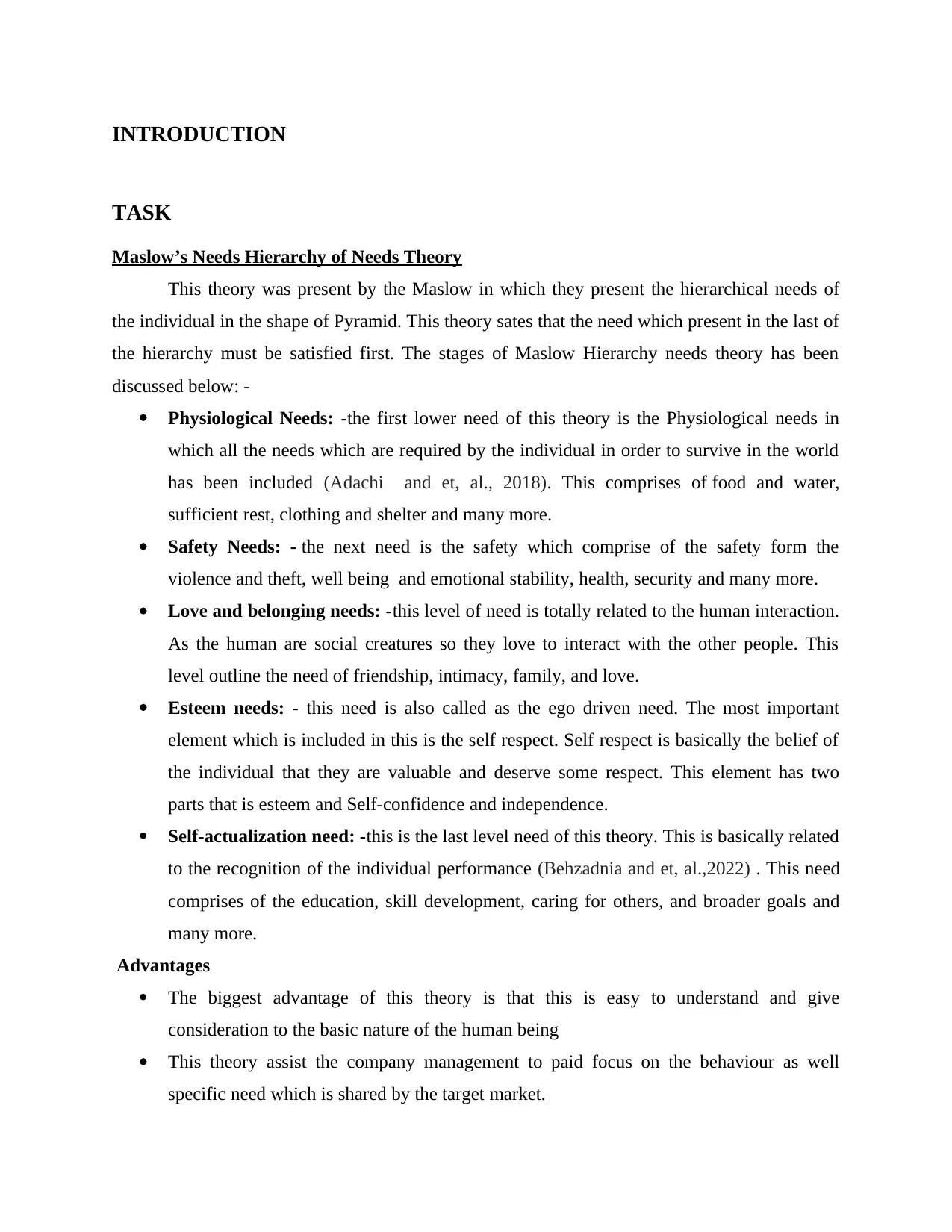
INTRODUCTION
TASK
Maslow’s Needs Hierarchy of Needs Theory
This theory was present by the Maslow in which they present the hierarchical needs of
the individual in the shape of Pyramid. This theory sates that the need which present in the last of
the hierarchy must be satisfied first. The stages of Maslow Hierarchy needs theory has been
discussed below: -
Physiological Needs: -the first lower need of this theory is the Physiological needs in
which all the needs which are required by the individual in order to survive in the world
has been included (Adachi and et, al., 2018). This comprises of food and water,
sufficient rest, clothing and shelter and many more.
Safety Needs: - the next need is the safety which comprise of the safety form the
violence and theft, well being and emotional stability, health, security and many more.
Love and belonging needs: -this level of need is totally related to the human interaction.
As the human are social creatures so they love to interact with the other people. This
level outline the need of friendship, intimacy, family, and love.
Esteem needs: - this need is also called as the ego driven need. The most important
element which is included in this is the self respect. Self respect is basically the belief of
the individual that they are valuable and deserve some respect. This element has two
parts that is esteem and Self-confidence and independence.
Self-actualization need: -this is the last level need of this theory. This is basically related
to the recognition of the individual performance (Behzadnia and et, al.,2022) . This need
comprises of the education, skill development, caring for others, and broader goals and
many more.
Advantages
The biggest advantage of this theory is that this is easy to understand and give
consideration to the basic nature of the human being
This theory assist the company management to paid focus on the behaviour as well
specific need which is shared by the target market.
TASK
Maslow’s Needs Hierarchy of Needs Theory
This theory was present by the Maslow in which they present the hierarchical needs of
the individual in the shape of Pyramid. This theory sates that the need which present in the last of
the hierarchy must be satisfied first. The stages of Maslow Hierarchy needs theory has been
discussed below: -
Physiological Needs: -the first lower need of this theory is the Physiological needs in
which all the needs which are required by the individual in order to survive in the world
has been included (Adachi and et, al., 2018). This comprises of food and water,
sufficient rest, clothing and shelter and many more.
Safety Needs: - the next need is the safety which comprise of the safety form the
violence and theft, well being and emotional stability, health, security and many more.
Love and belonging needs: -this level of need is totally related to the human interaction.
As the human are social creatures so they love to interact with the other people. This
level outline the need of friendship, intimacy, family, and love.
Esteem needs: - this need is also called as the ego driven need. The most important
element which is included in this is the self respect. Self respect is basically the belief of
the individual that they are valuable and deserve some respect. This element has two
parts that is esteem and Self-confidence and independence.
Self-actualization need: -this is the last level need of this theory. This is basically related
to the recognition of the individual performance (Behzadnia and et, al.,2022) . This need
comprises of the education, skill development, caring for others, and broader goals and
many more.
Advantages
The biggest advantage of this theory is that this is easy to understand and give
consideration to the basic nature of the human being
This theory assist the company management to paid focus on the behaviour as well
specific need which is shared by the target market.
⊘ This is a preview!⊘
Do you want full access?
Subscribe today to unlock all pages.

Trusted by 1+ million students worldwide
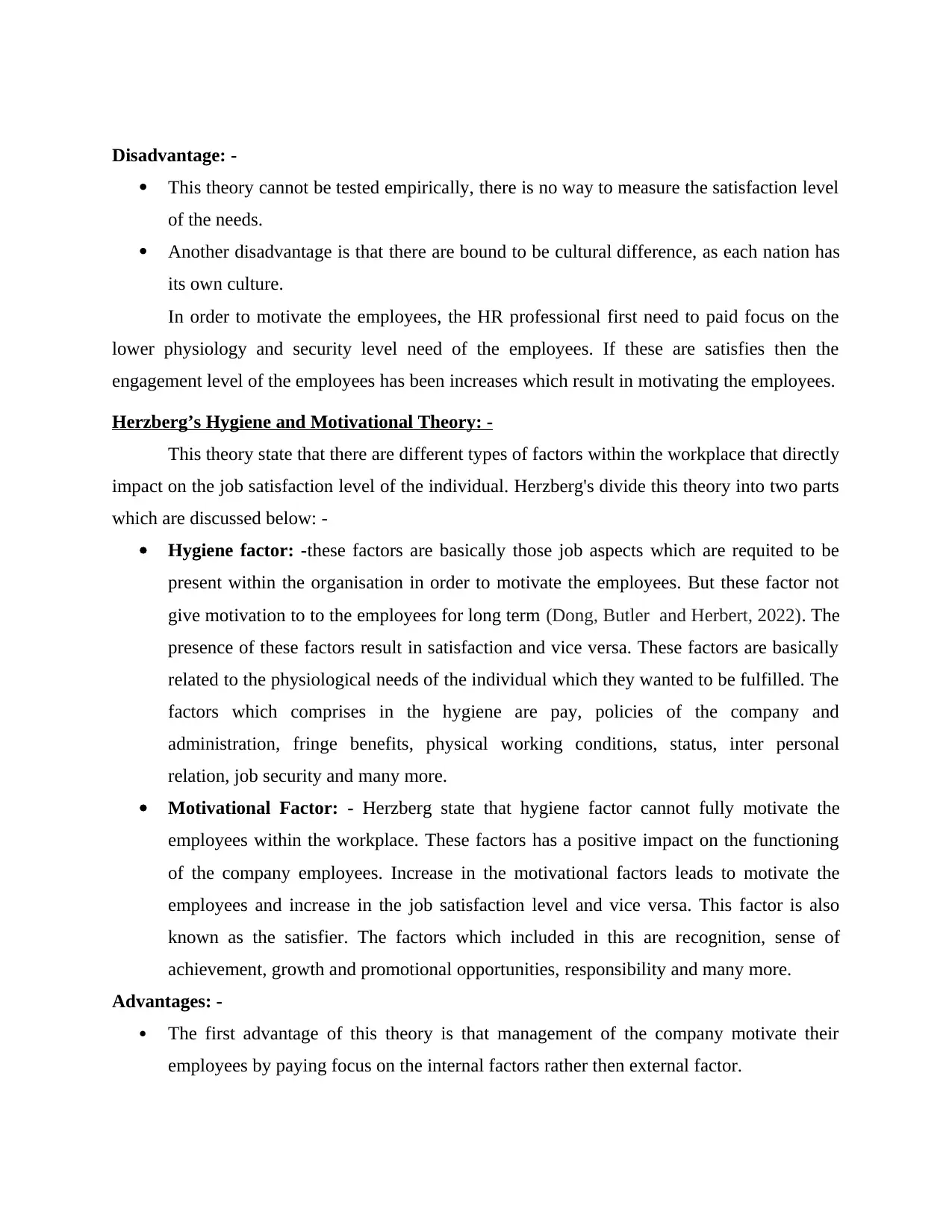
Disadvantage: -
This theory cannot be tested empirically, there is no way to measure the satisfaction level
of the needs.
Another disadvantage is that there are bound to be cultural difference, as each nation has
its own culture.
In order to motivate the employees, the HR professional first need to paid focus on the
lower physiology and security level need of the employees. If these are satisfies then the
engagement level of the employees has been increases which result in motivating the employees.
Herzberg’s Hygiene and Motivational Theory: -
This theory state that there are different types of factors within the workplace that directly
impact on the job satisfaction level of the individual. Herzberg's divide this theory into two parts
which are discussed below: -
Hygiene factor: -these factors are basically those job aspects which are requited to be
present within the organisation in order to motivate the employees. But these factor not
give motivation to to the employees for long term (Dong, Butler and Herbert, 2022). The
presence of these factors result in satisfaction and vice versa. These factors are basically
related to the physiological needs of the individual which they wanted to be fulfilled. The
factors which comprises in the hygiene are pay, policies of the company and
administration, fringe benefits, physical working conditions, status, inter personal
relation, job security and many more.
Motivational Factor: - Herzberg state that hygiene factor cannot fully motivate the
employees within the workplace. These factors has a positive impact on the functioning
of the company employees. Increase in the motivational factors leads to motivate the
employees and increase in the job satisfaction level and vice versa. This factor is also
known as the satisfier. The factors which included in this are recognition, sense of
achievement, growth and promotional opportunities, responsibility and many more.
Advantages: -
The first advantage of this theory is that management of the company motivate their
employees by paying focus on the internal factors rather then external factor.
This theory cannot be tested empirically, there is no way to measure the satisfaction level
of the needs.
Another disadvantage is that there are bound to be cultural difference, as each nation has
its own culture.
In order to motivate the employees, the HR professional first need to paid focus on the
lower physiology and security level need of the employees. If these are satisfies then the
engagement level of the employees has been increases which result in motivating the employees.
Herzberg’s Hygiene and Motivational Theory: -
This theory state that there are different types of factors within the workplace that directly
impact on the job satisfaction level of the individual. Herzberg's divide this theory into two parts
which are discussed below: -
Hygiene factor: -these factors are basically those job aspects which are requited to be
present within the organisation in order to motivate the employees. But these factor not
give motivation to to the employees for long term (Dong, Butler and Herbert, 2022). The
presence of these factors result in satisfaction and vice versa. These factors are basically
related to the physiological needs of the individual which they wanted to be fulfilled. The
factors which comprises in the hygiene are pay, policies of the company and
administration, fringe benefits, physical working conditions, status, inter personal
relation, job security and many more.
Motivational Factor: - Herzberg state that hygiene factor cannot fully motivate the
employees within the workplace. These factors has a positive impact on the functioning
of the company employees. Increase in the motivational factors leads to motivate the
employees and increase in the job satisfaction level and vice versa. This factor is also
known as the satisfier. The factors which included in this are recognition, sense of
achievement, growth and promotional opportunities, responsibility and many more.
Advantages: -
The first advantage of this theory is that management of the company motivate their
employees by paying focus on the internal factors rather then external factor.
Paraphrase This Document
Need a fresh take? Get an instant paraphrase of this document with our AI Paraphraser
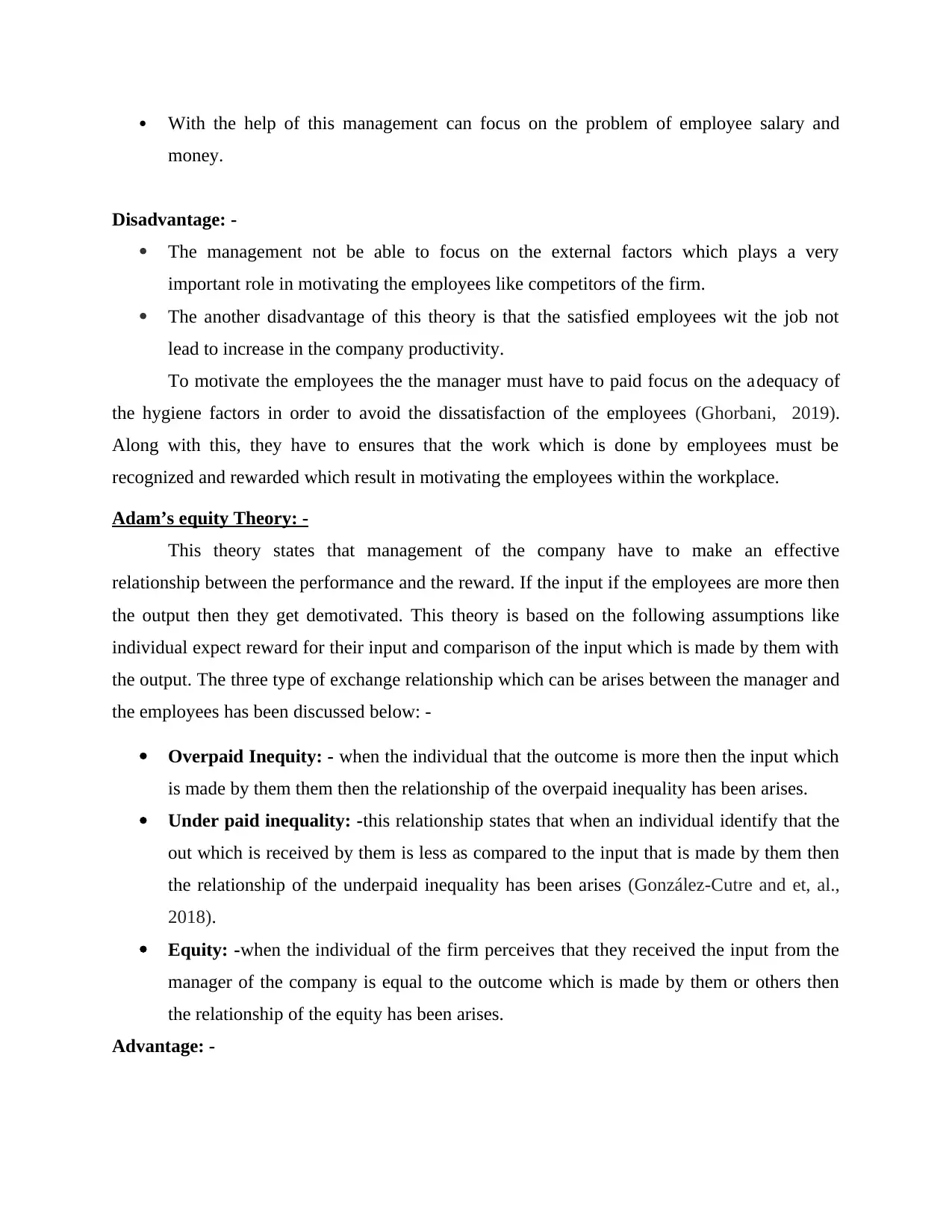
With the help of this management can focus on the problem of employee salary and
money.
Disadvantage: -
The management not be able to focus on the external factors which plays a very
important role in motivating the employees like competitors of the firm.
The another disadvantage of this theory is that the satisfied employees wit the job not
lead to increase in the company productivity.
To motivate the employees the the manager must have to paid focus on the adequacy of
the hygiene factors in order to avoid the dissatisfaction of the employees (Ghorbani, 2019).
Along with this, they have to ensures that the work which is done by employees must be
recognized and rewarded which result in motivating the employees within the workplace.
Adam’s equity Theory: -
This theory states that management of the company have to make an effective
relationship between the performance and the reward. If the input if the employees are more then
the output then they get demotivated. This theory is based on the following assumptions like
individual expect reward for their input and comparison of the input which is made by them with
the output. The three type of exchange relationship which can be arises between the manager and
the employees has been discussed below: -
Overpaid Inequity: - when the individual that the outcome is more then the input which
is made by them them then the relationship of the overpaid inequality has been arises.
Under paid inequality: -this relationship states that when an individual identify that the
out which is received by them is less as compared to the input that is made by them then
the relationship of the underpaid inequality has been arises (González-Cutre and et, al.,
2018).
Equity: -when the individual of the firm perceives that they received the input from the
manager of the company is equal to the outcome which is made by them or others then
the relationship of the equity has been arises.
Advantage: -
money.
Disadvantage: -
The management not be able to focus on the external factors which plays a very
important role in motivating the employees like competitors of the firm.
The another disadvantage of this theory is that the satisfied employees wit the job not
lead to increase in the company productivity.
To motivate the employees the the manager must have to paid focus on the adequacy of
the hygiene factors in order to avoid the dissatisfaction of the employees (Ghorbani, 2019).
Along with this, they have to ensures that the work which is done by employees must be
recognized and rewarded which result in motivating the employees within the workplace.
Adam’s equity Theory: -
This theory states that management of the company have to make an effective
relationship between the performance and the reward. If the input if the employees are more then
the output then they get demotivated. This theory is based on the following assumptions like
individual expect reward for their input and comparison of the input which is made by them with
the output. The three type of exchange relationship which can be arises between the manager and
the employees has been discussed below: -
Overpaid Inequity: - when the individual that the outcome is more then the input which
is made by them them then the relationship of the overpaid inequality has been arises.
Under paid inequality: -this relationship states that when an individual identify that the
out which is received by them is less as compared to the input that is made by them then
the relationship of the underpaid inequality has been arises (González-Cutre and et, al.,
2018).
Equity: -when the individual of the firm perceives that they received the input from the
manager of the company is equal to the outcome which is made by them or others then
the relationship of the equity has been arises.
Advantage: -
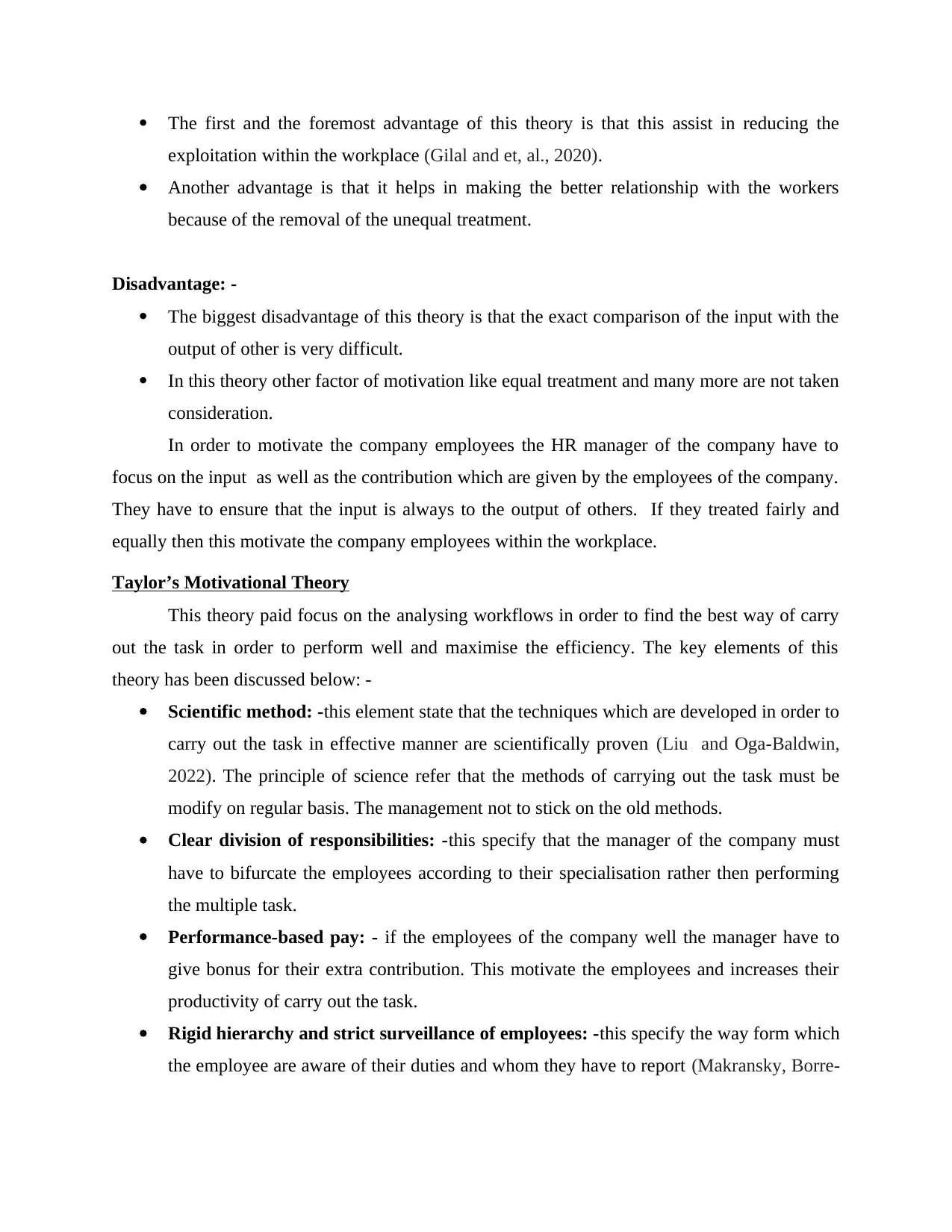
The first and the foremost advantage of this theory is that this assist in reducing the
exploitation within the workplace (Gilal and et, al., 2020).
Another advantage is that it helps in making the better relationship with the workers
because of the removal of the unequal treatment.
Disadvantage: -
The biggest disadvantage of this theory is that the exact comparison of the input with the
output of other is very difficult.
In this theory other factor of motivation like equal treatment and many more are not taken
consideration.
In order to motivate the company employees the HR manager of the company have to
focus on the input as well as the contribution which are given by the employees of the company.
They have to ensure that the input is always to the output of others. If they treated fairly and
equally then this motivate the company employees within the workplace.
Taylor’s Motivational Theory
This theory paid focus on the analysing workflows in order to find the best way of carry
out the task in order to perform well and maximise the efficiency. The key elements of this
theory has been discussed below: -
Scientific method: -this element state that the techniques which are developed in order to
carry out the task in effective manner are scientifically proven (Liu and Oga-Baldwin,
2022). The principle of science refer that the methods of carrying out the task must be
modify on regular basis. The management not to stick on the old methods.
Clear division of responsibilities: -this specify that the manager of the company must
have to bifurcate the employees according to their specialisation rather then performing
the multiple task.
Performance-based pay: - if the employees of the company well the manager have to
give bonus for their extra contribution. This motivate the employees and increases their
productivity of carry out the task.
Rigid hierarchy and strict surveillance of employees: -this specify the way form which
the employee are aware of their duties and whom they have to report (Makransky, Borre‐
exploitation within the workplace (Gilal and et, al., 2020).
Another advantage is that it helps in making the better relationship with the workers
because of the removal of the unequal treatment.
Disadvantage: -
The biggest disadvantage of this theory is that the exact comparison of the input with the
output of other is very difficult.
In this theory other factor of motivation like equal treatment and many more are not taken
consideration.
In order to motivate the company employees the HR manager of the company have to
focus on the input as well as the contribution which are given by the employees of the company.
They have to ensure that the input is always to the output of others. If they treated fairly and
equally then this motivate the company employees within the workplace.
Taylor’s Motivational Theory
This theory paid focus on the analysing workflows in order to find the best way of carry
out the task in order to perform well and maximise the efficiency. The key elements of this
theory has been discussed below: -
Scientific method: -this element state that the techniques which are developed in order to
carry out the task in effective manner are scientifically proven (Liu and Oga-Baldwin,
2022). The principle of science refer that the methods of carrying out the task must be
modify on regular basis. The management not to stick on the old methods.
Clear division of responsibilities: -this specify that the manager of the company must
have to bifurcate the employees according to their specialisation rather then performing
the multiple task.
Performance-based pay: - if the employees of the company well the manager have to
give bonus for their extra contribution. This motivate the employees and increases their
productivity of carry out the task.
Rigid hierarchy and strict surveillance of employees: -this specify the way form which
the employee are aware of their duties and whom they have to report (Makransky, Borre‐
⊘ This is a preview!⊘
Do you want full access?
Subscribe today to unlock all pages.

Trusted by 1+ million students worldwide
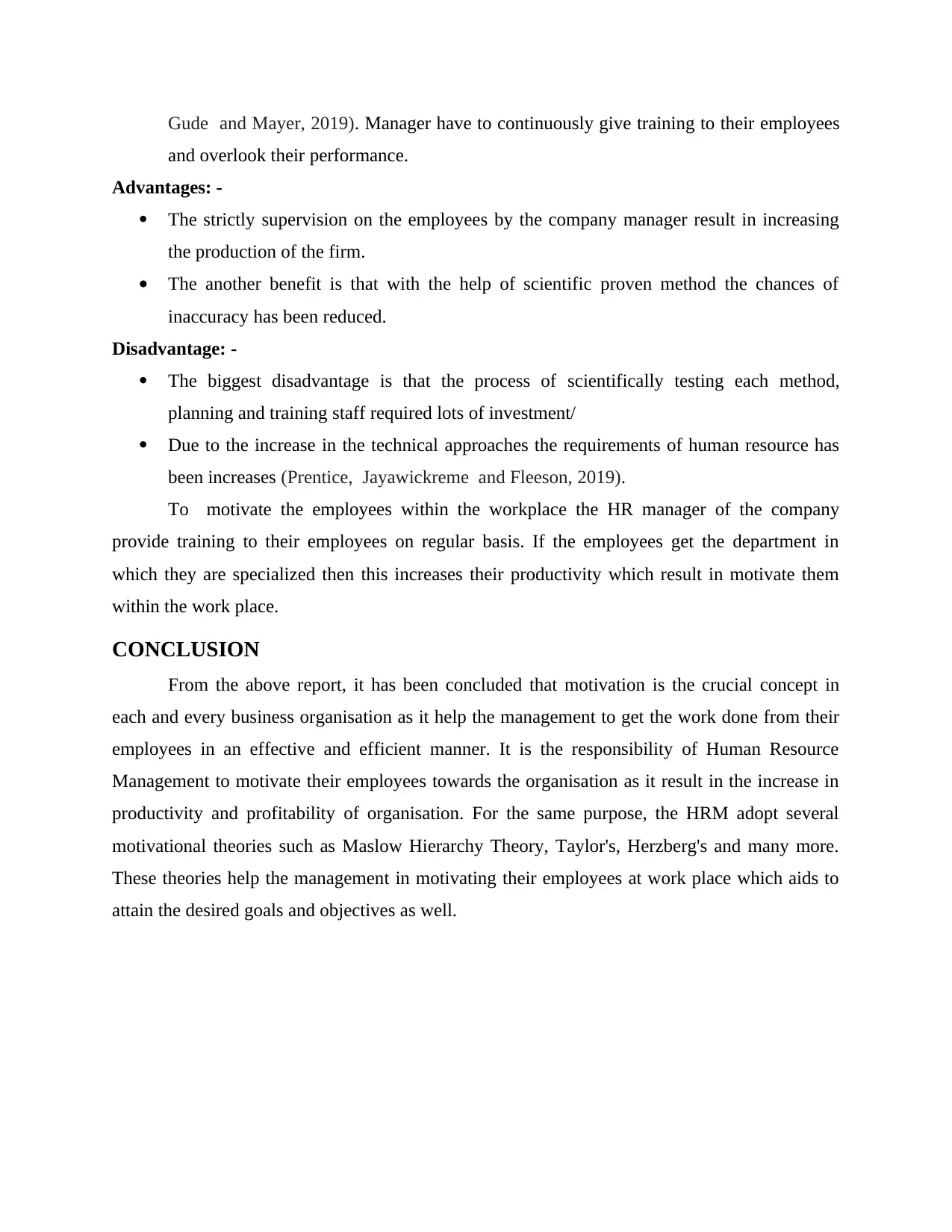
Gude and Mayer, 2019). Manager have to continuously give training to their employees
and overlook their performance.
Advantages: -
The strictly supervision on the employees by the company manager result in increasing
the production of the firm.
The another benefit is that with the help of scientific proven method the chances of
inaccuracy has been reduced.
Disadvantage: -
The biggest disadvantage is that the process of scientifically testing each method,
planning and training staff required lots of investment/
Due to the increase in the technical approaches the requirements of human resource has
been increases (Prentice, Jayawickreme and Fleeson, 2019).
To motivate the employees within the workplace the HR manager of the company
provide training to their employees on regular basis. If the employees get the department in
which they are specialized then this increases their productivity which result in motivate them
within the work place.
CONCLUSION
From the above report, it has been concluded that motivation is the crucial concept in
each and every business organisation as it help the management to get the work done from their
employees in an effective and efficient manner. It is the responsibility of Human Resource
Management to motivate their employees towards the organisation as it result in the increase in
productivity and profitability of organisation. For the same purpose, the HRM adopt several
motivational theories such as Maslow Hierarchy Theory, Taylor's, Herzberg's and many more.
These theories help the management in motivating their employees at work place which aids to
attain the desired goals and objectives as well.
and overlook their performance.
Advantages: -
The strictly supervision on the employees by the company manager result in increasing
the production of the firm.
The another benefit is that with the help of scientific proven method the chances of
inaccuracy has been reduced.
Disadvantage: -
The biggest disadvantage is that the process of scientifically testing each method,
planning and training staff required lots of investment/
Due to the increase in the technical approaches the requirements of human resource has
been increases (Prentice, Jayawickreme and Fleeson, 2019).
To motivate the employees within the workplace the HR manager of the company
provide training to their employees on regular basis. If the employees get the department in
which they are specialized then this increases their productivity which result in motivate them
within the work place.
CONCLUSION
From the above report, it has been concluded that motivation is the crucial concept in
each and every business organisation as it help the management to get the work done from their
employees in an effective and efficient manner. It is the responsibility of Human Resource
Management to motivate their employees towards the organisation as it result in the increase in
productivity and profitability of organisation. For the same purpose, the HRM adopt several
motivational theories such as Maslow Hierarchy Theory, Taylor's, Herzberg's and many more.
These theories help the management in motivating their employees at work place which aids to
attain the desired goals and objectives as well.
Paraphrase This Document
Need a fresh take? Get an instant paraphrase of this document with our AI Paraphraser
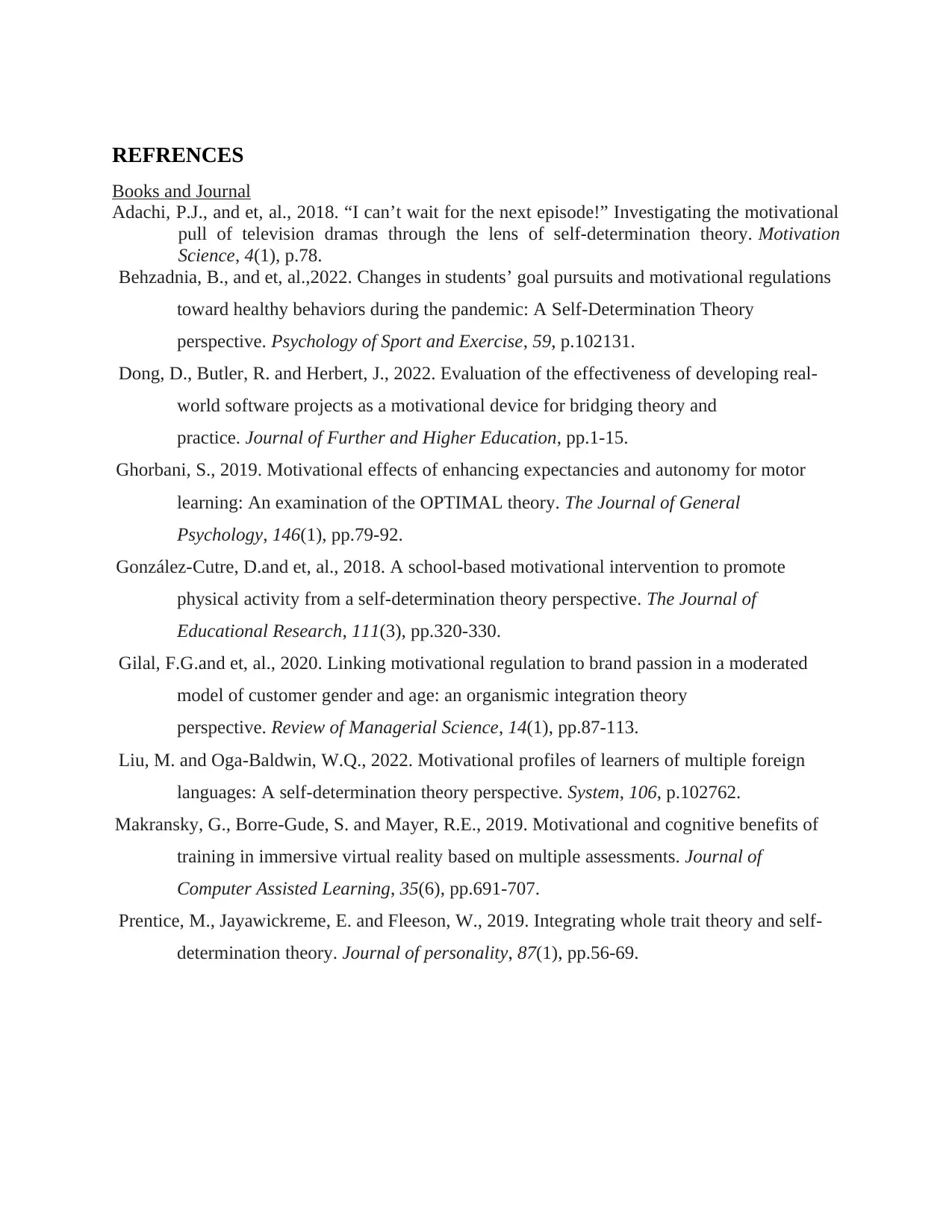
REFRENCES
Books and Journal
Adachi, P.J., and et, al., 2018. “I can’t wait for the next episode!” Investigating the motivational
pull of television dramas through the lens of self-determination theory. Motivation
Science, 4(1), p.78.
Behzadnia, B., and et, al.,2022. Changes in students’ goal pursuits and motivational regulations
toward healthy behaviors during the pandemic: A Self-Determination Theory
perspective. Psychology of Sport and Exercise, 59, p.102131.
Dong, D., Butler, R. and Herbert, J., 2022. Evaluation of the effectiveness of developing real-
world software projects as a motivational device for bridging theory and
practice. Journal of Further and Higher Education, pp.1-15.
Ghorbani, S., 2019. Motivational effects of enhancing expectancies and autonomy for motor
learning: An examination of the OPTIMAL theory. The Journal of General
Psychology, 146(1), pp.79-92.
González-Cutre, D.and et, al., 2018. A school-based motivational intervention to promote
physical activity from a self-determination theory perspective. The Journal of
Educational Research, 111(3), pp.320-330.
Gilal, F.G.and et, al., 2020. Linking motivational regulation to brand passion in a moderated
model of customer gender and age: an organismic integration theory
perspective. Review of Managerial Science, 14(1), pp.87-113.
Liu, M. and Oga-Baldwin, W.Q., 2022. Motivational profiles of learners of multiple foreign
languages: A self-determination theory perspective. System, 106, p.102762.
Makransky, G., Borre‐Gude, S. and Mayer, R.E., 2019. Motivational and cognitive benefits of
training in immersive virtual reality based on multiple assessments. Journal of
Computer Assisted Learning, 35(6), pp.691-707.
Prentice, M., Jayawickreme, E. and Fleeson, W., 2019. Integrating whole trait theory and self‐
determination theory. Journal of personality, 87(1), pp.56-69.
Books and Journal
Adachi, P.J., and et, al., 2018. “I can’t wait for the next episode!” Investigating the motivational
pull of television dramas through the lens of self-determination theory. Motivation
Science, 4(1), p.78.
Behzadnia, B., and et, al.,2022. Changes in students’ goal pursuits and motivational regulations
toward healthy behaviors during the pandemic: A Self-Determination Theory
perspective. Psychology of Sport and Exercise, 59, p.102131.
Dong, D., Butler, R. and Herbert, J., 2022. Evaluation of the effectiveness of developing real-
world software projects as a motivational device for bridging theory and
practice. Journal of Further and Higher Education, pp.1-15.
Ghorbani, S., 2019. Motivational effects of enhancing expectancies and autonomy for motor
learning: An examination of the OPTIMAL theory. The Journal of General
Psychology, 146(1), pp.79-92.
González-Cutre, D.and et, al., 2018. A school-based motivational intervention to promote
physical activity from a self-determination theory perspective. The Journal of
Educational Research, 111(3), pp.320-330.
Gilal, F.G.and et, al., 2020. Linking motivational regulation to brand passion in a moderated
model of customer gender and age: an organismic integration theory
perspective. Review of Managerial Science, 14(1), pp.87-113.
Liu, M. and Oga-Baldwin, W.Q., 2022. Motivational profiles of learners of multiple foreign
languages: A self-determination theory perspective. System, 106, p.102762.
Makransky, G., Borre‐Gude, S. and Mayer, R.E., 2019. Motivational and cognitive benefits of
training in immersive virtual reality based on multiple assessments. Journal of
Computer Assisted Learning, 35(6), pp.691-707.
Prentice, M., Jayawickreme, E. and Fleeson, W., 2019. Integrating whole trait theory and self‐
determination theory. Journal of personality, 87(1), pp.56-69.
1 out of 8
Related Documents
Your All-in-One AI-Powered Toolkit for Academic Success.
+13062052269
info@desklib.com
Available 24*7 on WhatsApp / Email
![[object Object]](/_next/static/media/star-bottom.7253800d.svg)
Unlock your academic potential
Copyright © 2020–2025 A2Z Services. All Rights Reserved. Developed and managed by ZUCOL.





